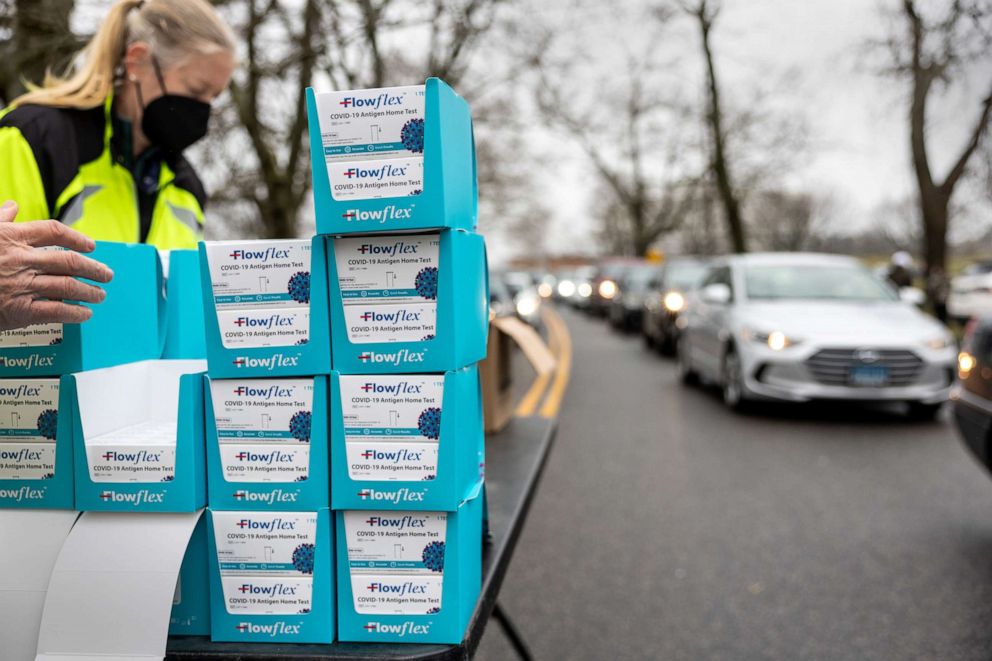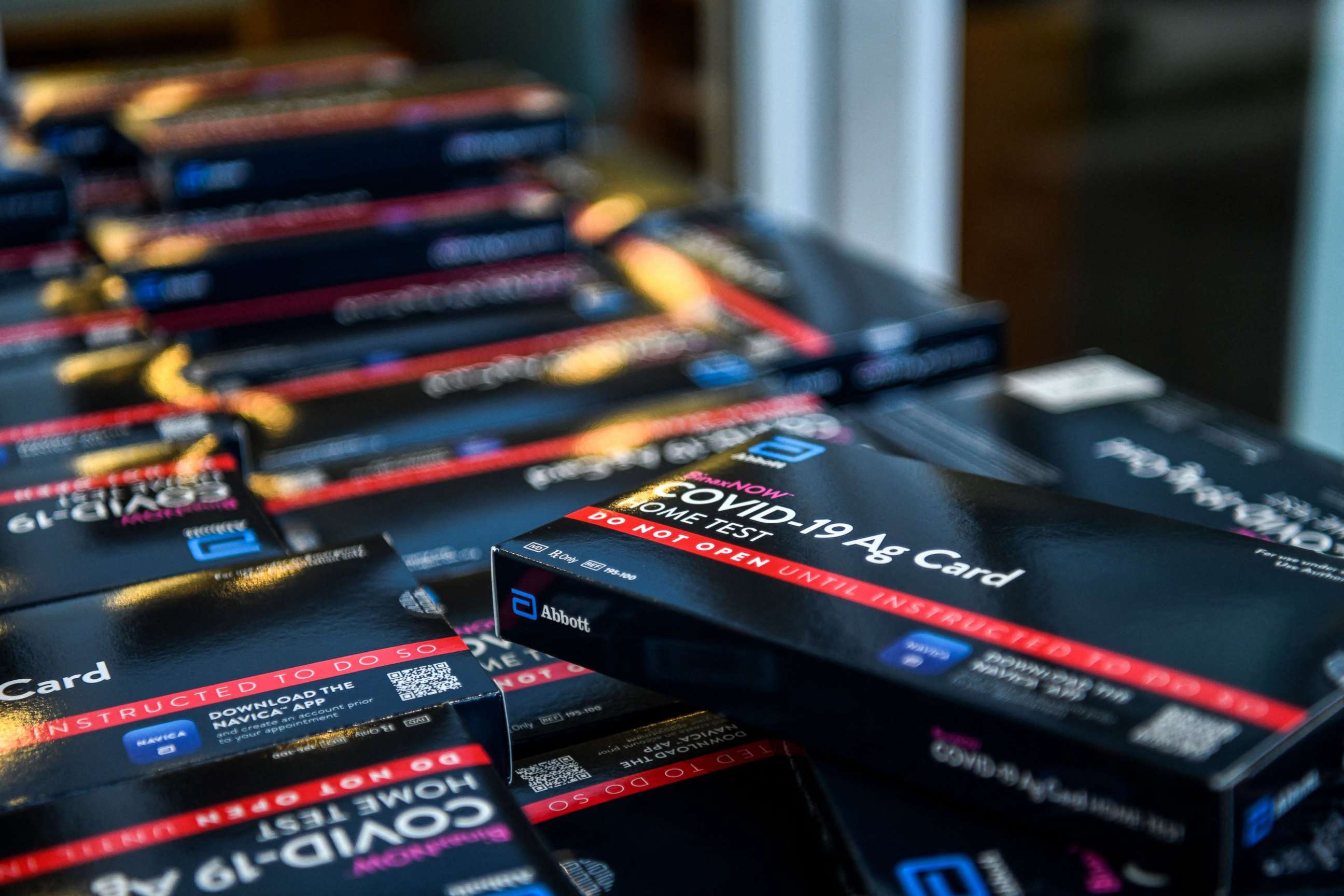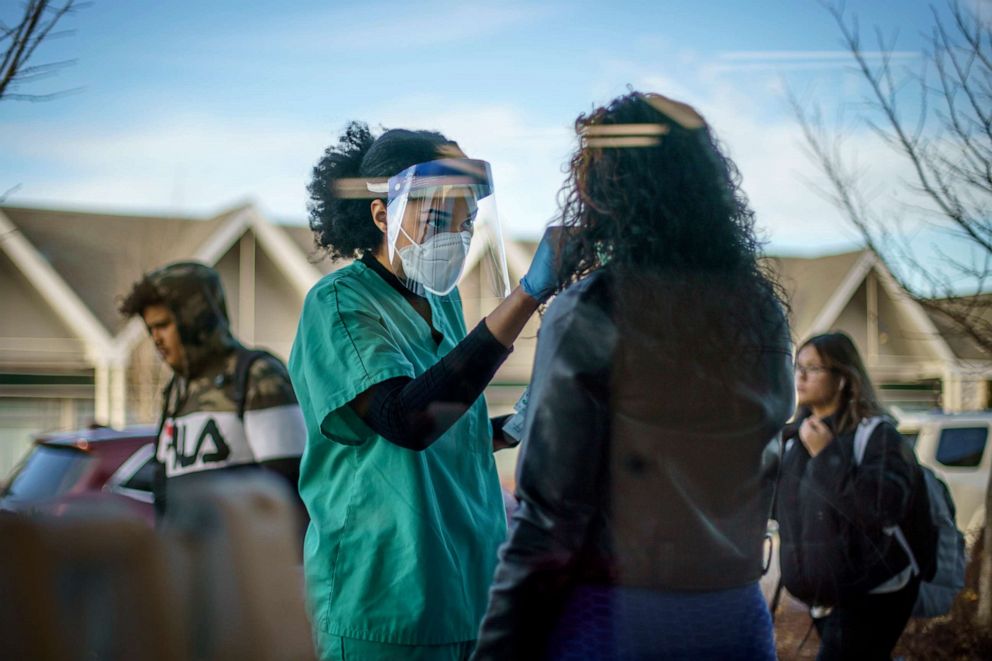What you need to know about at-home COVID tests
At-home tests have soared in popularity as lab tests have become harder to get.
With the rise of the highly transmissible omicron variant and the need for widespread testing at school and work, as well as over the holidays, at-home COVID-19 tests have exploded in popularity in the U.S. over the last several weeks.
The shift came amid reports of long lines and scarce appointments for testing sites around the country and longer-than-normal turnaround times for lab results, leaving Americans seeking other options to find out if they were infected.
The Centers for Disease Control and Prevention (CDC) and other health officials recommend people use at-home tests if they have COVID-19 symptoms, have been exposed or potentially exposed to an individual with COVID-19 or before gathering indoors. On Thursday, President Joe Biden said his administration is attempting to acquire 500 million additional free at-home tests to distribute to Americans, bringing the total promised to 1 billion.
But with several different brands available on the market and changing testing guidance from the CDC, Americans may wonder how the tests work and how they should be used.
ABC News spoke with two infectious disease experts about how to use at-home rapid tests and what the results mean.

What are at-home tests and how should they be used?
At-home tests, also known as rapid tests, look for antigens, or proteins, of the coronavirus and return results very quickly, typically within an hour and some within minutes. These are different from lab tests, known as PCR tests. They look for viral genetic material but can take up to three days to return results.
With PCR tests, a patient does not need a lot of viral genetic material in their nose for a result to be positive compared to a rapid test.
"For the at-home test to be positive, you actually have to have quite a bit of protein from the virus," Dr. Susan Butler-Wu, an associate professor of pathology at the University of Southern California Keck School of Medicine, told ABC News.
To make sure the test is being performed correctly, experts recommend people make sure they have a clean workspace and to carefully read the instructions.
"When you have the test open and you are getting the swab, there are going to be instructions about whether to put it in one or both sides of the nose and how long to have it there and how many times to turn it," Dr. Stuart Ray, a professor of medicine at Johns Hopkins University, told ABC News. "Those instructions are important because you want to get an adequate sample."
The swab is then placed in a liquid, which is turn placed on a piece of paper and flows up through a strip. Most tests have one line to indicate a negative result and two lines for a positive result.
Because some lines can be faint or hard to see with the naked eye, Ray recommends taking a photo of the result with a cell phone to confirm it.
Can I use at-home tests if I'm symptomatic?
The CDC recommends that Americans can use at-home tests, regardless of vaccination status or whether or not they have symptoms.
If the result is positive, the agency suggests staying home or isolating for at least five days and wearing a mask around others for additional five days.
Although Americans may wonder if their results are a false positive, the experts say that when there are high amounts of COVID-19 in the community -- such as during the omicron surge -- a positive result from an at-home test is likely a true positive.
"Right now, when COVID-19 is absolutely surging, if I have symptoms and I get a positive result [on an at-home test], I should assume that this is COVID because we know there's so much of it circulating," Butler-Wu said. "But, for instance, if we were to come out of this wave and I'm symptomatic and I test myself and it's positive, I may need to confirm that because we know there's not much circulating virus."
Ray added, "They often come two in a pack for a reason. It's a good idea if you get a surprising result to repeat that." The CDC recommends repeat (or serial) testing based on the test manufacturer's instructions.
Additionally, the CDC advises telling close contacts that they may have been exposed to COVID-19 so they can get tested and/or quarantine.

What if I'm asymptomatic?
If a person is asymptomatic but has been exposed to someone with COVID-19, the experts recommend testing five days after exposure regardless of vaccination status.
If the result from the at-home test is positive, the CDC says the person should isolate for five days, assuming no symptoms develop. Butler-Wu said it's a good idea to confirm with a PCR test.
Ray agreed that a person should make sure they're positive by getting a lab test.
"Go to an urgent care center or a state facility to get a test to see whether it's a true positive," he said. "The value there is that, right now, we have a limited supply of medicines that can be used to prevent severe COVID but, depending on the situation, the person, there may be opportunities to prevent you from getting sicker so it's worth at least whether or not this is truly COVID."
However, if the at-home test is negative, the experts suggest waiting a day or two and then test again. This is because a negative result from a rapid test does not mean a person is not infected but rather that the virus could not be detected yet.
They also suggest Americans follow CDC guidance about quarantine and isolation based on vaccination status.
Does a negative at-home test result mean I can gather with people?
The CDC recommends that Americans self-test before gathering indoors, especially with people who are not in their households.
A positive result means a person is infected and should not socialize with others and should isolate for at least five days, according to CDC guidance. A negative test means a person is unlikely to be infectious.
The agency also urges those who are not fully vaccinated or are aged 2 and older to wear a mask in indoor public spaces. However, masks are not recommended for outdoor gatherings.
Should I report my positive at-home COVID-19 test result?
Although there are some at-home COVID-19 tests that automatically report results, most do not.
"The reporting piece for at-home tests is a hot mess, to be honest," Butler-Wu said. "In most cases, it's up to folks to do it themselves, which we know isn't happening in the vast majority of cases."

This means that the average number of 761,000 cases per day (as of Jan. 13) is likely much higher.
Ray said people with positive results should contact their doctor or the local health authorities to be added to the official count.
However, he urged Americans with mild symptoms not to call 911 or visit the emergency room, with hospitals reporting exponential increases in people visiting just to get tested.
"If they are very ill, of course, they should seek urgent or emergency care as appropriate. But if they are not very ill, they should avoid adding to already-overwhelmed emergency services," he said.
Can I use an at-home test to leave quarantine or isolation early?
The experts strongly recommend against this and urge any COVID-positive patients to complete at least five full days of isolation after first developing symptoms or first testing positive.
When the CDC released its updated isolation and quarantine guidance at the end of December, the agency did not recommend taking a test before exiting. The guidelines were later updated to suggest people can take a test on Day 5, if possible.
"If after five days your symptoms have resolved or are nearly resolved, then a rapid test negative would be reassuring that you don't pose a big risk to others,'' Ray said. "If you're positive with a rapid test at that point, be extremely cautious about going out because it's likely that you're infectious."
The CDC advises anyone who tests positive for COVID-19, regardless of vaccination status, can leave their house after five days as long as they no longer have symptoms. However, they are also advised to wear a mask around others for five additional days, in accordance with CDC guidance.
Those who have been exposed to a COVID-19 patient but have been boosted or received the Pfizer or Moderna vaccine less than six months ago or the Johnson & Johnson vaccine less than two months ago do not have to quarantine but are recommended to wear a mask around others for 10 days and to test on Day 5, if possible.
Lastly, those who have been exposed but are unvaccinated or unboosted and received their Pfizer or Moderna vaccine more than six months ago or the Johnson & Johnson vaccine more than two months ago are advised to stay home for five days and then wear a mask around others for an additional five days, as well as to get tested if possible on Day 5.
Both doctors recommend that COVID-positive patients continue to wear well-fitting masks for another five days and avoid all essential travel.




